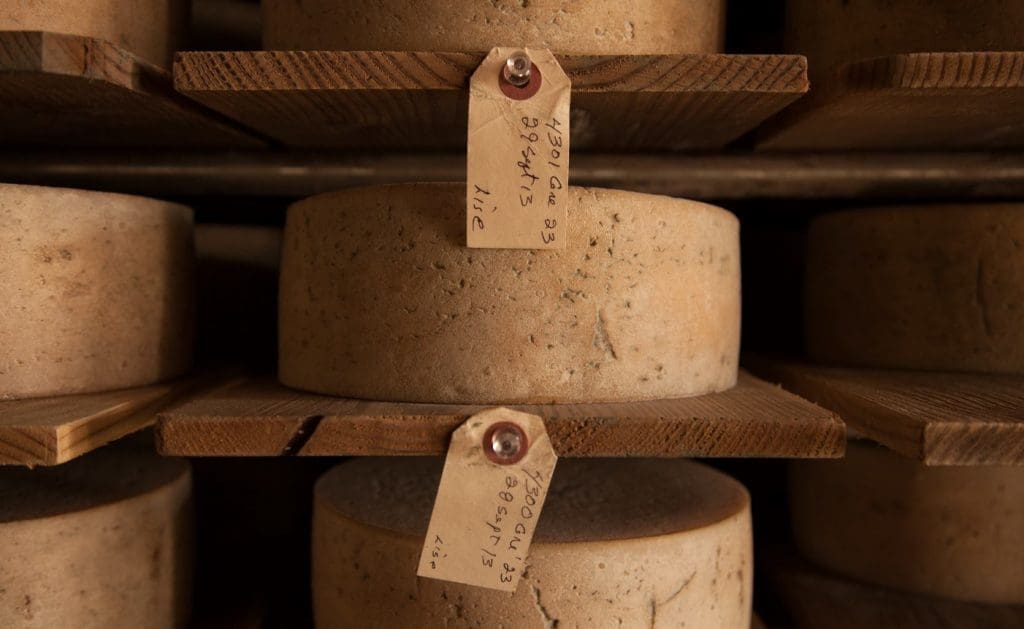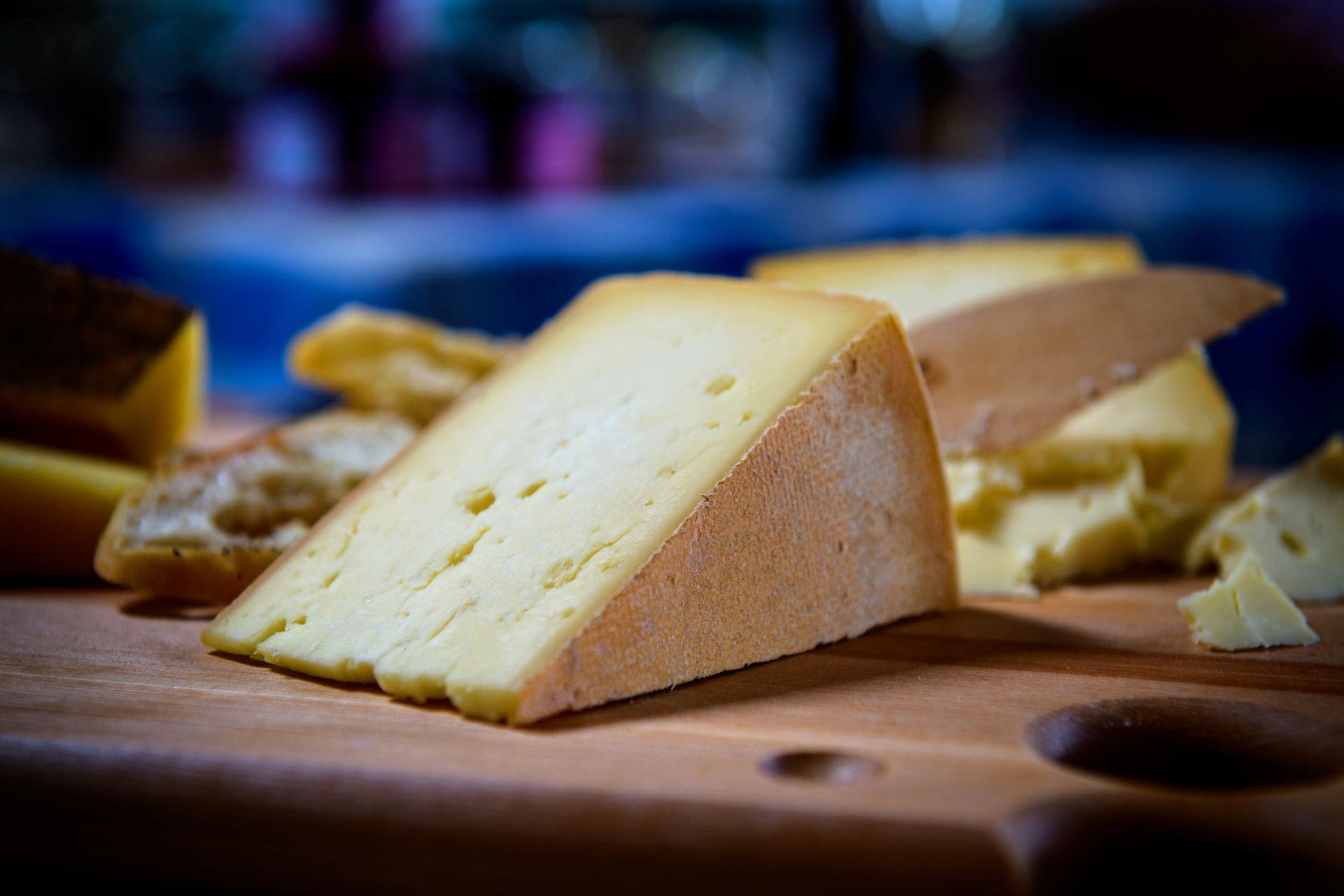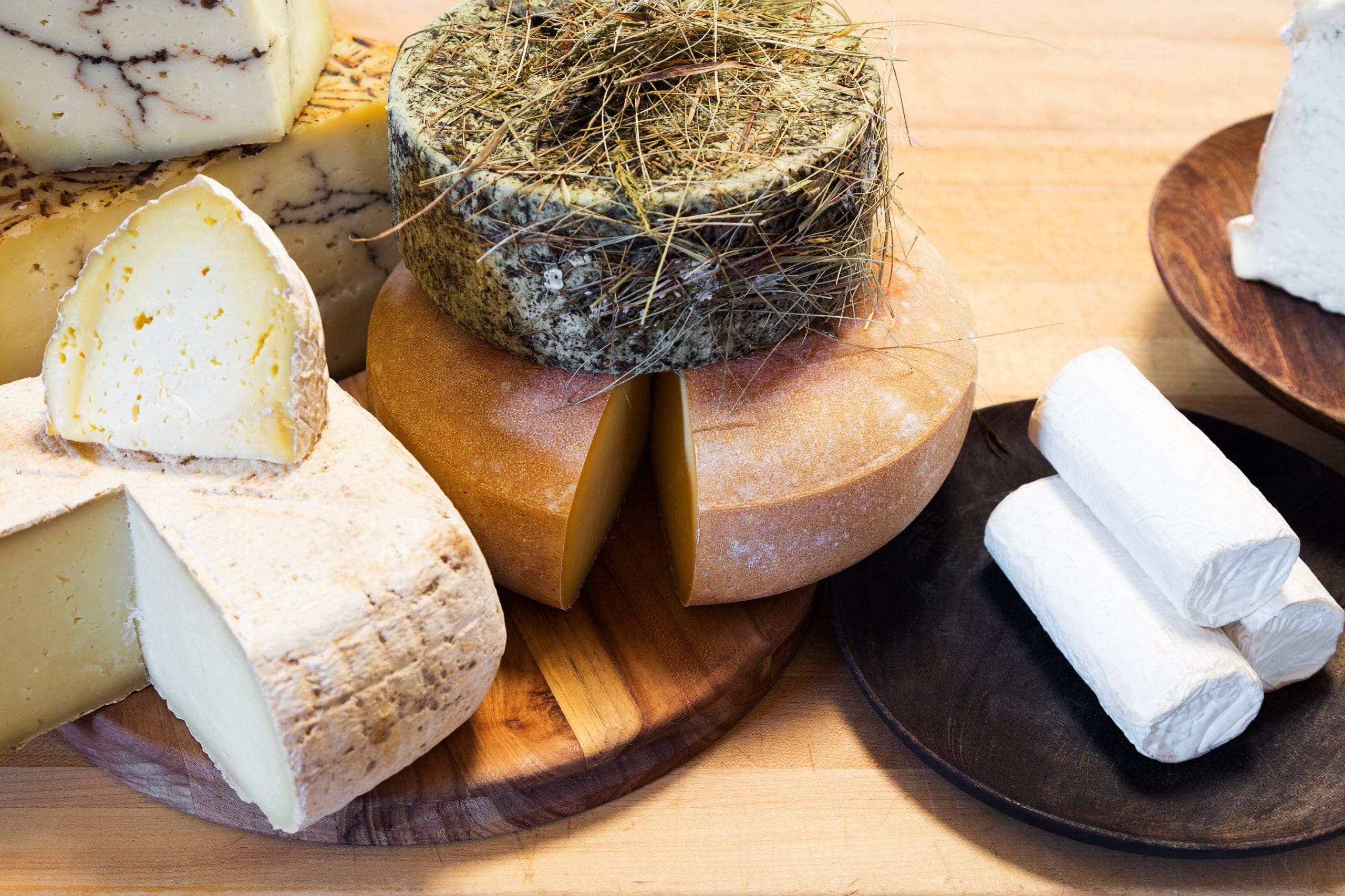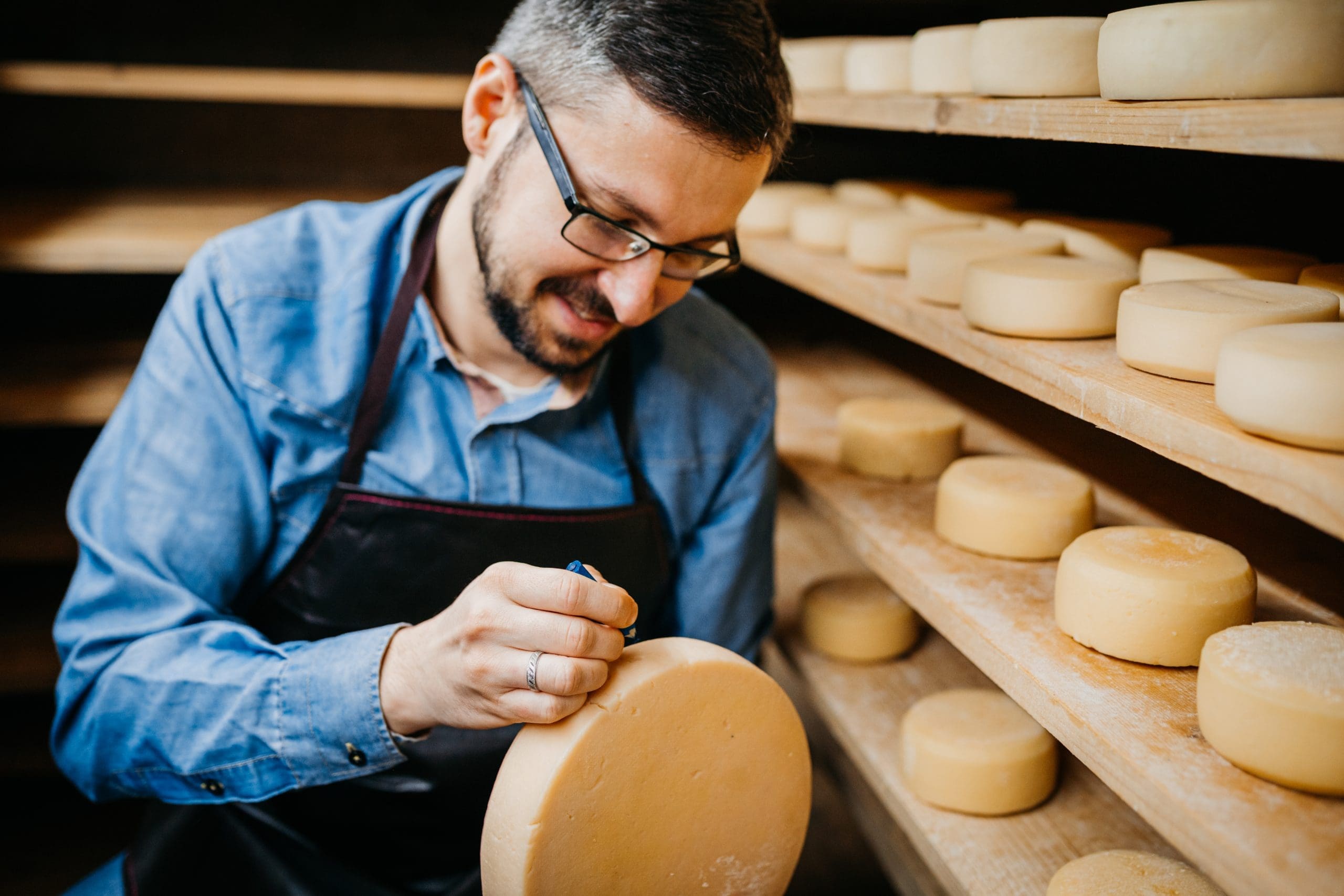Holey, smoky, ripened, full-bodied, runny or skouik under the tooth, cheese from our region has long been one of the darling products that everyone loves. With no fewer than 900 creations, the possibilities for aperitifs, raclettes, fondues and more are almost limitless! That said, there’s still a lot to discover about them. So much, in fact, that we thought we’d bring you a wealth of practical and even amusing information to help you perfect your knowledge of the subject. Here’s a summary of our explorations. 🧀🔍

From New France to today, the story of Quebec cheese
You won’t be surprised to learn that the expertise of our producers goes back a long way. In fact, historian Catherine Ferland(1) recounts that the arrival of Samuel de Champlain and the first settlers in New France, in 1608, truly marked the beginning of the Quebec cheese epic. With the entry of the French Regime into the Quebec region came a rich baggage of skills. 📜
From then on, around 1635, a number of settlers began to develop their land along the St. Lawrence valley, notably on Île d’Orléans, a unique and immensely fertile territory that would become one of the main production sites. The pioneers developed simple, unadorned bloomy-rind cheeses, such as Le Paillasson de l’Isle d’Orléans, the first to be made in America. For the curious, its name refers to the reed mat on which it was laid to dry over the stove. 🌾🧀
Otherwise, Le Raffiné de l’Isle, also known as Le Raffiné de Saint-Pierre, stood out from the crowd and gained in popularity. So much so, in fact, that the governor of New France was prepared to send his cook by ship to obtain it.(1) Since then, cheese production has been going full steam ahead, and it’s clear that the expertise and inventiveness of our craftsmen and women have expanded rapidly. In particular, the introduction of the English Regime led to the production of an impressive variety of cheeses (thanks to new recipes, techniques, etc.), including the famous cheddar, essentially imported from the days of New France. 🏴🧀
Speaking of imports, in 1820-1830, the majority of cheeses eaten in Quebec came from the United States. However, the agricultural crisis that swept Canada in the early 19th century turned the situation around, forcing farmers to reinvent themselves, betting, among other things, on local production. This turnaround finally made Quebec a major exporter on the international scene, especially with cheddar cheese in England. Companies such as Fromagerie Perron (1895) were instrumental in this. The same goes for the famous Oka cheese, made by the monks of the Trappe d’Oka, which was an instant success from its creation in 1893. 🌍🧀
This milestone was followed by many others, including the establishment of the École de laiterie de Saint-Hyacinthe (1893), cheese-making by the monks of the Abbaye de Saint-Benoît-du-Lac (1943), the arrival in Quebec of Swiss-born artisan cheesemaker Fritz Kaiser (1980s), etc.(3) 🎓🧀

Cheese 101: what you need to know
In Quebec, over 200,000 tonnes of cheese are produced every year, and of this figure, almost 33,500 are dedicated to the creation of fine cheeses(2). These impressive figures demonstrate (in part!) just how versatile this resource is, shaping itself according to its territory and surroundings. Cheese makers literally make magic! ✨🧀
Do you seem to have lost your way in this abundance? Are you at a loss to choose the right cheese or cheeses to satisfy your taste buds, those of your family or your guests? To give you a helping hand, we’ve broken down the 5 main categories(3) of pasta:
-
Soft pasta: with a refined, slightly acidic taste and a smooth, creamy, sometimes runny texture. Highly versatile, mozzarellas, bries and camemberts, in double or triple cream versions, are good examples.
-
Blue-veined: or the famous blue cheeses! Easy to recognize, this type of cheese is generally smooth, dense and covered with a thin natural rind. Its lively, characterful flavors are said to make excellent sauces.
-
Semi-firm pasta: here we’re talking about soft, smooth textures. When ripened, these cheeses have hazelnut or mushroom flavors. Raclette, pizza mozzarella and grilled cheeses are all examples.
-
Firm cheeses: if you’re a fan of cheddar, gouda, Swiss, brick and the like, you’ll love firm cheeses! Generally rindless, they are distinguished by their tender, elastic texture, which is easy to grate. These cheeses are just as good for everyday use as they are for social occasions.
-
Fresh pasta: unctuous, delicate, light and delicate – that’s the best way to describe fresh pasta. Always crustless, it’s a wonderful spread or dip. Think ricotta, cottage, goat or cream cheeses, to name but a few.
In addition to these ranges, there are special cheeses such as fondue, raw milk, thermized milk, organic, granulated, reduced-fat, lactose-free, grilled and spreadable. There are as many cheeses as there are ways of cooking and enjoying them. Keep in mind, though, that pairings are ultra-easy. Just let your creativity flow! 🤩🍷

Facts with bite
The cheese experts’ site, known as Les Fromages d’ici, is packed with content so interesting you can easily surf for a loooong time! From America’s first piece of cheese to cooking and tasting techniques, every possible angle is explored! Here are the ones that piqued our curiosity and, by the way, might spark yours. 🖥️🧀
-
Can you guess the most popular cheese in Quebec and around the world? Unsurprisingly, it’s… cheddar!
-
What’s the secret to a crisp, melt-in-your-mouth gratin? It’s been said that the best allies for a successful gratin are cheeses containing rennet or microbial enzymes, such as pizza mozzarella, Monterey Jack or Gouda.
-
Quebecers are big consumers of fine cheeses, consuming 5 to 6 kg per person per year, compared to 4 kg for the rest of Canada!
-
Is the rind edible or not? If it’s red, orange or shiny yellow, it’s wax or kerosene, in this case synthetic and inedible. Otherwise, most rinds, whether washed, ashed or pressed, are safe to eat.
-
CWho hasn’t cooked a cheese sauce that ended up as a lump? The trick to a smooth sauce is to add an acidic element, such as lemon juice, to the basic ingredients. Alternatively, start your sauce with a roux (a mixture of butter and flour) to make it easier. High heat should be avoided at all costs, so turn down the heat or remove the pan from the hob before gradually incorporating the cheese.
-
Cheeses should always be tempered 45 minutes (on average) before cutting.
Cheese activities
Why not take advantage of a regional getaway to visit your favorite producers? In every corner of the province, cheese dairies open their doors and their fields, welcoming you, chatting with you, presenting their classics, their new products and, as a bonus, offering you the chance to taste them. Many even dare to organize out-of-the-ordinary events (such as an open-air raclette) where gourmet delights are threaded together. Take a look at the directory to find out! 🚗🧀
Finally, an appellation contrôlée!
The long-awaited nomination of farmhouse cheeses will finally join the ranks of the existing Appellations Réservées Québécoises (IGP): Charlevoix Lamb (recognized in 2009), Ice Cider (2014), Ice Wine (2014), Neuville Corn (2017) and Quebec Wine (2018).
The “Fromage fermier”(4) designation, due to be introduced in 2022, is essentially aimed at promoting and recognizing local cheeses. Failing that, it will enable consumers to identify them straightaway and make better-informed choices, especially when it comes to buying local.
The enhanced term Fromage fermier offers a guarantee of authenticity and a visual identity easily identifiable by consumers looking for cheeses made according to a distinctive cheese-making expertise that highlights the creative know-how of Quebec’s agricultural producers and the vitality of the regions. – Le Conseil des appellations réservées et des termes valorisants. 🏆🧀
Farmhouse cheese reminder
How can you tell the difference between farmhouse and artisan cheese? The main distinction between the two lies in the origin of the raw material: the milk. Farmhouse cheese is made directly on the farm. The creative process is masterfully controlled by the cheesemaker, down to the smallest detail.
Artisanal cheese, on the other hand, is hand-carved from the milk of one or more nearby farms. As a result, the cheesemaker must work closely with nearby dairy producers to obtain the highest quality raw material.
In the industry, this new distinction is seen as a major gain in the recognition of the work of our artisans, not to mention the validation of their talents. It’s the perfect opportunity to savour this victory with a double-crème, in honour of the best cheeses in the world, those made right here at home! 👨🌾🧀
Sources :
(1)Radio-Canada, Aujourd’hui l’histoire, L’histoire du fromage au Québec racontée par Catherine Ferland, 3 septembre 2021
(2)La Presse, Producteurs de lait du Québec, Fromages: le savoir d’ici en chiffres, 28 octobre 2019
(3)Les Fromages d’ici
(4)Radio-Canada, Ici Saguenay-Lac-Saint-Jean, Une appellation réservée pour les fromages fermiers, 4 mai 2021
(5) Les Fromages d’ici, On dit oui à l’arrivée des Fromages fermiers, 2021








